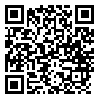Volume 16, Issue 2 (March & April 2025)
BCN 2025, 16(2): 429-440 |
Back to browse issues page
Download citation:
BibTeX | RIS | EndNote | Medlars | ProCite | Reference Manager | RefWorks
Send citation to:



BibTeX | RIS | EndNote | Medlars | ProCite | Reference Manager | RefWorks
Send citation to:
Ghadiry F, Amra B, Feizi A, Vafaei Shahi M. Evaluating the Validity of Sleep Disturbance Scale for Children in Attention-deficit/Hyperactivity Disorder. BCN 2025; 16 (2) :429-440
URL: http://bcn.iums.ac.ir/article-1-2698-en.html
URL: http://bcn.iums.ac.ir/article-1-2698-en.html
1- Sleep Ward, Department Internal Medicine, Isfahan University of Medical Sciences, Isfahan, Iran.
2- Pulmonary and Sleep Ward, Department of Internal Medicine, Isfahan University Of Medical Sciences, Isfahan, Iran.
3- Department of Epidemiology and Biostatistics, School of Health, Isfahan University of Medical Sciences, Isfahan, Iran. & Cardiac Rehabilitation Research Center, Cardiovascular Research Institute, Isfahan University of Medical Sciences, Isfahan, Iran.
4- Department of Psychiatry, School of Medicine, Isfahan University of Medical Sciences, Isfahan, Iran.
2- Pulmonary and Sleep Ward, Department of Internal Medicine, Isfahan University Of Medical Sciences, Isfahan, Iran.
3- Department of Epidemiology and Biostatistics, School of Health, Isfahan University of Medical Sciences, Isfahan, Iran. & Cardiac Rehabilitation Research Center, Cardiovascular Research Institute, Isfahan University of Medical Sciences, Isfahan, Iran.
4- Department of Psychiatry, School of Medicine, Isfahan University of Medical Sciences, Isfahan, Iran.
Abstract:
Introduction: Attention-deficit/hyperactivity disorder (ADHD) is prevalent in children and strongly associated with sleep disorders, emphasizing the clinical importance of diagnosing sleep disorders in these patients. Here, we aimed to assess the validity of the sleep disturbance scale for children (SDSC) in children with ADHD.
Methods: This cross-sectional study, conducted between 2020 and 2021, involved 204 children diagnosed with ADHD and 202 healthy children as controls. Participants were recruited using convenience sampling from schools, community centers, and pediatric clinics. Demographic data were collected for all participants, and their parents completed the SDSC. The results of the two groups were analyzed and compared using the factor analysis method to examine question-answering patterns and item discrimination for ADHD disorder.
Results: The mean total SDSC score was significantly higher in ADHD patients than in controls (68.1±20.4 vs 57.3±18.2; P<0.05). ADHD cases also exhibited significantly higher scores in disorders of initiating and maintaining sleep (DIMS) (21.6±7.5 vs 18.1±26.9; P<0.001), sleep disorder of breathing (SDB) (5.5±3.5 vs 4.9±2.5; P=0.006), the disorder of arousal (DA) (5.9±4.0 vs 4.4±2.7; P<0.001), sleep-wake transition disorders (SWTDs) (17.8±6.6 vs 14.6±6.2; P<0.001), and sleep hyperhidrosis (SHY) (4.5±3.5 vs 3.6±3.1; P=0.013) subscales. However, the area under the curve of all subscales was unsatisfactory (ranging from 0.54 to 0.63).
Conclusion: ADHD patients displayed notably higher SDSC scores, particularly in the disorders of initiating and maintaining sleep, which exhibited the highest sensitivity. These findings emphasize the clinical relevance of using SDSC for diagnosing and addressing sleep disorders in individuals with ADHD.
Methods: This cross-sectional study, conducted between 2020 and 2021, involved 204 children diagnosed with ADHD and 202 healthy children as controls. Participants were recruited using convenience sampling from schools, community centers, and pediatric clinics. Demographic data were collected for all participants, and their parents completed the SDSC. The results of the two groups were analyzed and compared using the factor analysis method to examine question-answering patterns and item discrimination for ADHD disorder.
Results: The mean total SDSC score was significantly higher in ADHD patients than in controls (68.1±20.4 vs 57.3±18.2; P<0.05). ADHD cases also exhibited significantly higher scores in disorders of initiating and maintaining sleep (DIMS) (21.6±7.5 vs 18.1±26.9; P<0.001), sleep disorder of breathing (SDB) (5.5±3.5 vs 4.9±2.5; P=0.006), the disorder of arousal (DA) (5.9±4.0 vs 4.4±2.7; P<0.001), sleep-wake transition disorders (SWTDs) (17.8±6.6 vs 14.6±6.2; P<0.001), and sleep hyperhidrosis (SHY) (4.5±3.5 vs 3.6±3.1; P=0.013) subscales. However, the area under the curve of all subscales was unsatisfactory (ranging from 0.54 to 0.63).
Conclusion: ADHD patients displayed notably higher SDSC scores, particularly in the disorders of initiating and maintaining sleep, which exhibited the highest sensitivity. These findings emphasize the clinical relevance of using SDSC for diagnosing and addressing sleep disorders in individuals with ADHD.
Keywords: Attention deficit disorder with hyperactivity (ADHD), Sleep-wake disorders, Surveys and questionnaires
Type of Study: Original |
Subject:
Clinical Neuroscience
Received: 2023/04/29 | Accepted: 2024/03/2 | Published: 2025/03/1
Received: 2023/04/29 | Accepted: 2024/03/2 | Published: 2025/03/1
Send email to the article author
| Rights and permissions | |
 |
This work is licensed under a Creative Commons Attribution-NonCommercial 4.0 International License. |








